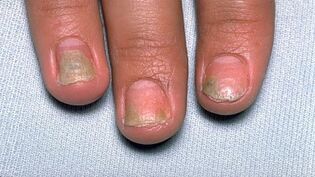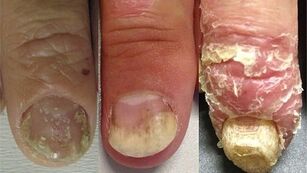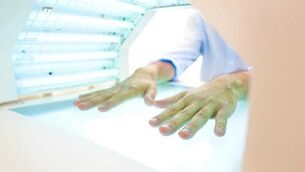Psoriasis of the nails is one of the types of a chronic dermatological disease. If there are suitable factors for the spread, it may disturb the adult or child. The disease has many similarities with ordinary psoriasis, because it is also characterized by pathological layering of cells, resulting in a strong deformation of the nail plates.
Causes of the disease

Some people believe that psoriasis of the nails or toenails develops when there is severe stress. Although it has been scientifically proven that strong emotional experiences cannot cause such changes. Therefore, they cannot be taken as the main reason for the development of the disease. Doctors actually identify two factors that can cause a pathological process:
- Immune system disorders areresponsible for the formation of healthy cells and the fermentation of substances. Such changes do not allow the full development of skin particles. They begin to grow and overlap. The result is a thickening of the nail plates;
- Prone to the development of psoriasis.Most patients have a genetic predisposition to pathological development. It wakes up immediately after the body is negatively affected by certain factors.
There are several factors that can trigger the disease:
- Hormonal deficiency;
- Metabolic problems;
- Long-term use of anti-inflammatory drugs and beta-blockers;
- Climatic conditions (cold and dry weather);
- Chronic fatigue;
- Infectious lesions;
- Damage to the upper layers of the skin.
In half of the cases, psoriasis of the nails on the hands or feet develops along with skin lesions.
Psoriasis can only affect the nails or other parts of the body.
The first signs of psoriasis on fingernails and toenails
Nail lesions in psoriasis are characterized by symptoms characteristic of this condition. From the first days of the disease, they start to bother a person. Common symptoms of the pathological process include:
- Holes and grooves on the surface of nail plates;
- Change the color of the nail to dark;
- Inflammatory process at the edges of the nails;
- Itching is felt on the skin of the fingers.
If treatment is not started in the early stages of the disease, it will continue to grow and the clinical manifestations will be more pronounced.
Stages of the disease

You can find out what a nail psoriasis looks like by carefully examining a photo showing the affected plates and fingers. The manifestation of pathology in the early stages of development is not very clear. With the successful spread of psoriasis affecting healthy tissues, an increase in symptoms is observed.
Doctors distinguish 3 main stages of the process of nail psoriasis:
- progressive.At this stage, the nail begins to be covered with small dots painted in a white or yellowish brown color. Increases the size of papules over time. At this stage, psoriasis does not affect the deeper layers of the nail, so it can be treated quickly. There is no pain when pressing on the affected area, but the surface is gradually peeled off;
- Stationary.Dots stop appearing on nails. At the same time, inflammatory processes slow down. However, anxiety or pain persists. Sometimes at this stage, the skin near the plaques is covered with disease-specific rashes. Itself is very dry;
- Regressive.Previously formed rashes are actively disappearing. Whiteish edges appear next to the lesions. As a rule, at this stage of the development of psoriasis, patients suffer from intolerable itching.
Physicians who observe the development of a disease must understand what stage it is at. This will help them find the optimal therapy for the patient.
If left untreated, psoriasis will invade new areas.
Diagnostic methods
An experienced specialist who diagnoses and treats dermatological diseases can immediately determine if a person has psoriasis on the nails. Laboratory tests allow you to check the accuracy of the results. You may need to make a diagnosis:
- Complete blood count;
- Biopsy or analysis of psoriatic scales.
No instrumental diagnosis is required for nail psoriasis.
How to treat nail psoriasis

Nail psoriasis in children and adults requires complex therapy. One tool or procedure is not enough for such a diagnosis. Treatment of psoriasis of the nails on the hands or feet is standard for all patients. Individually, selected drugs and physiotherapy are selected. In addition, the patient will be advised to re-adjust their daily diet and make significant adjustments to their normal lifestyle. Indeed, the success of a therapeutic course depends on it.
As soon as a person sees signs of nail psoriasis, he should immediately consult a dermatologist. What symptoms will help to recognize the disease was discussed above.
Most doctors prescribe topical ointments and systemic tablets
Drug treatment
Treatment for a disease such as nail psoriasis can be done at home. The doctor will prescribe a number of medications that need to be taken orally or applied to the affected areas.
In the early stages of dermatological pathology, a local remedy should be used. Ointments and creams can be hormonal or non-hormonal. First, it is required for advanced forms of the disease.
Non-hormonal drugs rarely cause side effects and complications. In addition, unlike more aggressive preparations for the external treatment of the nail plate, they do not cause addiction.
If a patient's nail is severely affected, the doctor may recommend oral medication. It will tell you how to treat nail psoriasis in this way and what dose to follow.
The following medications may be needed for psoriasis:
- Immunomodulators (vitamins);
- Antihistamines;
- Sedatives.
In most cases, medications are not stopped until the disease subsides.
Physiotherapy

Finger nail psoriasis is often treated with physiotherapy. A good result for such violations:
provided by- PUVA therapy;
- x-ray therapy;
- UV radiation;
- Ultrasound treatment;
- Laser therapy.
The number and duration of physiotherapy sessions should be chosen correctly so that the result is only positive after the procedure. This work should be entrusted to an experienced specialist. Otherwise, the patient trying to understand how to treat psoriasis will face serious side effects of the treatment procedure.
PUVA therapy is one of the most modern and effective methods.
Appropriate Nail Care
For the treatment to be as effective as possible, the patient with psoriasis should pay attention to nail care. The disease seriously damages their plates, so such care is no longer necessary. First of all, it is to follow the rules of hygiene. Doctors recommend the following for this diagnosis:
- Nails should be cut as short as possible;
- It is recommended to wear protective gloves when doing housework;
- Avoid activities that could damage the nails and surrounding skin;
- You should regularly monitor the cleanliness of nail plates.
Medical methods will be more effective if the patient follows these rules in addition to folk and traditional therapies.
In psoriasis, it is especially important to protect your hands from aggressive influences.
Folk remedies
Traditional medicine experts know which plant improves psoriasis, which affects the nail plate. Like many other herbs, they are recommended when preparing home remedies for the treatment of dermatological diseases.
Patients can use the following folk remedies:
- Celandine juice. To prepare, you need to pour 2 tablespoons of 0. 5 liters of water. l. horses. This mixture should be boiled over low heat. Bake for an average of about 30 minutes. After that, medicinal baths are prepared from the broth, and the arms and legs are lowered into them for 20-25 minutes;
- Natural oils.These foods work well with psoriasis. Sea buckthorn oil is especially useful. Hydrates skin around nails & enriches with beneficial trace elementsTo treat the affected area with oil, you need to apply it to a cotton pad and then pass it over the plate. It is recommended to repeat the procedure up to 3 times a day;
- Onion compress.It is made from medium onions, previously passed through a meat grinder. The resulting gruel is placed on the nails and covered with a clean bandage. The compress should be kept for 30 minutes;
- bay leaf decoction.Can also be used in the preparation of medicinal baths. To prepare a broth you need to pour 2 cups of warm water with 20 g of grass. Cook the mixture for no more than 10 minutes. The product is then cooled to a comfortable temperature and lowered into the hands or feet. It is permissible to take such a decoction within 40 grams three times a day;
- Herbal decoction.You can make a remedy for baths from liver, chamomile, oak bark, sage and rope. They do this as in the previous recipe;
- Herbal infusion.Intended for oral administration. The home remedy is based on lingonberry leaves, St. John's wort, calamus root, celandine and sap. Ingredients are taken in equal proportions. The infusion is made from 1 tbsp. l. collection and a glass of boiling water. It is recommended to take 50 g of the drug twice a day.
Folk remedies should be used in conjunction with traditional treatments. Otherwise, there will be no effect.
Therapeutic Diet

When a person's upper skin layers are affected, poor nutrition can be blamed. Therefore, the body does not have useful trace elements that support the immune system and other systems. As you know, psoriatic disease occurs due to failures. Nails affected by psoriasis can be treated with a special diet. Must be hypoallergenic.
The diet of a patient with nail psoriasis should be balanced. It is strongly recommended to remove foods that can cause allergies. These are chocolate, strawberries, citrus fruits and coffee. You will also have to avoid salty, smoky, sour, spicy and fatty foods. Ketchup, mayonnaise and mustard are prohibited.
During the exacerbation of an autoimmune disease, it is recommended to follow a mono-diet for 1-2 days. Such nutrition involves the use of only 1 product. It can be apple, kefir, fish or cereal.
Therapeutic diet should be enriched with fermented dairy products, fruits, vegetables, herbs and lean fish.
Foods that can cause allergies can also increase psoriasis.
Prevention
Trying to prevent the development of nail psoriasis is easier than fighting it later. Prevention of the disease consists of following a number of recommendations:
- You should include plant foods in your diet;
- Fried, smoked, salty and salty foods should be avoided;
- It is advisable to regularly rest in places with a climate favorable for the skin and the body as a whole;
- Take vitamin and mineral complexes in courses;
- Avoid damaging the skin and nail plates;
- Treat infectious diseases in time.
Don't forget to take care of your skin and nails. This is the only way to protect yourself from the development of psoriasis and relapses.
Forecast
Psoriasis is one of the most common diseases. Medication and physical therapy only temporarily stop the development. No one was able to recover completely. If the patient follows the recommendations of a specialist, then he will be able to prevent re-damage of the skin and nails.
Complications and Consequences
Psoriatic nail lesions should be treated from the first days of development. If therapy is not available or is chosen incorrectly, the patient is at risk of complications and consequences of autoimmune disease.
Nail psoriasis can seriously affect the cardiovascular system. The greatest danger is the vessels, because under the influence of the disease they undergo pathological changes.
Any psoriasis can cause psychological problems. These are directly related to the normal approach of others to a person who rarely has similar defects in different parts of the body. For this reason, the patient becomes addicted, begins to abuse alcohol, and is constantly harassed by a depressed state. Against the background of a troubled psyche, the likelihood of malignant processes in skin cells increases.























